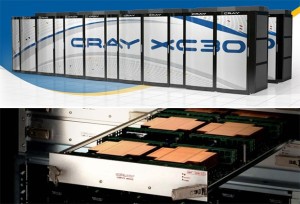Back in 2006, Cray announced a new strategy, called Adaptive Supercomputing, which was aimed at creating a single supercomputer architecture that could integrate multiple processing technologies. The slings and arrows of HPC trends haven’t led them off course with that mission, as the natural progression of its X30 (aka “Cascade”) story reveals.
Actively recalling that Adaptive Supercomputing vision, this morning company let fly that its XC30 supercomputer has stepped up its performance capability with the addition of support for both Xeon Phi coprocessors and NVIDIA Tesla 20X accelerators. Until this point, the system held steady with its Xeon-based roadmap, which was offered a fast lane with the company’s Aries interconnect and the Dragonfly topology—a set of system choices that Cray always touted as being primed for acceleration and coprocessor additions.
 In addition to being able to springboard off the Xeon E5, which alone provides 99 teraflops per cabinet, the X30 links its processor engine technology to the blade with a duet of configurable daughter cards that give Cascade its ability to march beyond standard CPUs. For those on the X30 upgrade warpath, these can be swapped or reconfigured without taking the blades out of place.
In addition to being able to springboard off the Xeon E5, which alone provides 99 teraflops per cabinet, the X30 links its processor engine technology to the blade with a duet of configurable daughter cards that give Cascade its ability to march beyond standard CPUs. For those on the X30 upgrade warpath, these can be swapped or reconfigured without taking the blades out of place.
This was not an entirely unexpected development following the announcement back in March that the Piz Daint supercomputer at the Swiss National Supercomputing Centre was getting an accelerator boost via GPU—the first of its kind on the XC30 front. According to Thomas Schulthess, professor at ETH Zurich and director of the Swiss National Supercomputing Center, the upgrade is already kicking out dividends on the performance and efficient fronts.
“Our first experience with climate and materials science applications showed that replacing one of the multi-core processors in the XC30 with an NVIDIA Tesla GPU boosts application performance and disproportionally reduced energy to solution,” Schulthess said. A recent test using a climate simulation on Piz Daint now runs over three times faster and reaching the solution with seven times less energy consumed as compared to CSCS’ current flagship system “Monte Rosa”. Further, according to CSCS, “Even compared to the exclusively CPU processors previously available in Piz Daint the hybrid system with the GPU processors is expected to run almost three times more energy-efficiently than with CPUs only.”
For more details about the center’s experiences with the upgrade and subsequent performance, Schulthess details it at length below..
“We designed the Cray XC30 supercomputer to be the realization of our Adaptive Supercomputing vision, which is about providing customers with a powerful, flexible tool for solving a multidisciplinary array of computing challenges,” said Peg Williams, Cray’s senior vice president of high performance computing systems. “Integrating diverse accelerator and coprocessor technologies into our XC30 systems gives our customers a variety of processing options for their demanding computational needs. Equally as important, Cray XC30 supercomputers feature an innovative software environment that allows our customers to optimize their use of diverse processing options for their unique applications.”
“Understanding that no single processor engine is ideal for every type of user application, the Cray XC30 series highlights the flexibility of scalar processing, coprocessing and accelerators to build hybrid systems capable of leveraging the strengths of each technology into one ‘adaptive’ HPC environment.” The company goes on to note that “merging x86 multicore benefits with coprocessor or accelerator manycore advantages addresses the need to target the best processing engine type for a specific function.”
Interestingly, when Cray’s Adaptive Supercomputing vision was announced, it was at the beginning of the “Rainier” era, which was dominated by AMD processors. As Cray has continued to branch out beyond a single processor vendor and processing paradigm, their seven-year journey toward that initial adaptive concept has certainly rounded the bend, offering them new inroads in both commercial and scientific computing environments. The lead-off from their Gemini interconnect via Aries opened the door for hybrid systems—and one has to wonder what impact that will have on the up-and-coming new crop of supers at the top tier of this November’s list.





























































